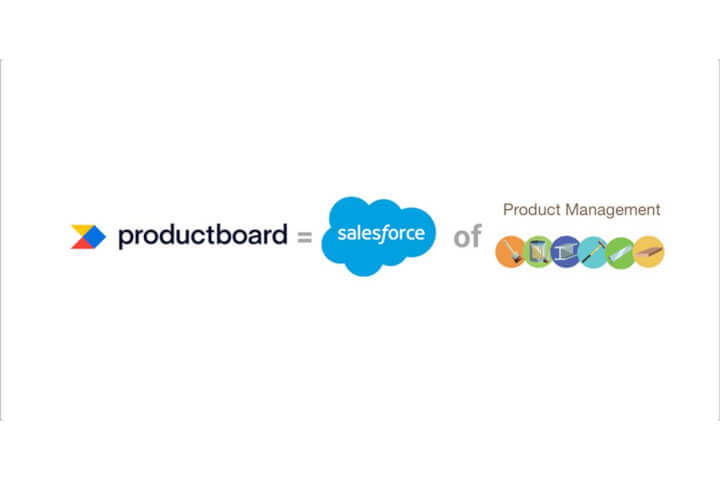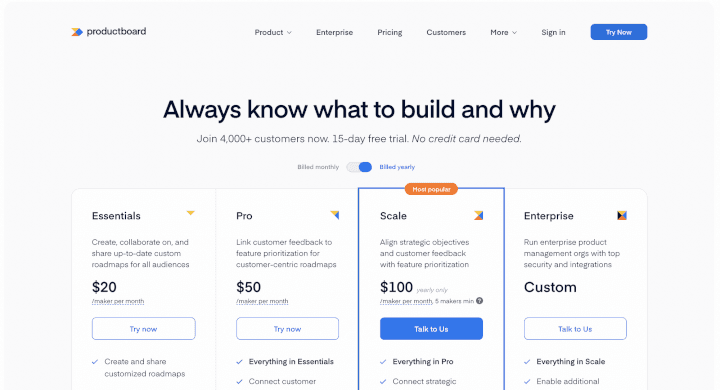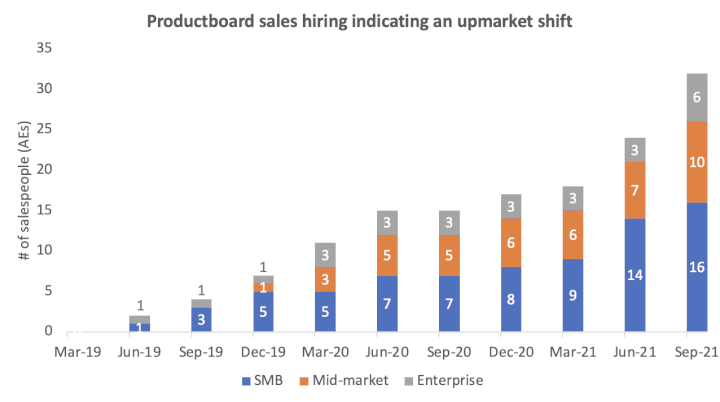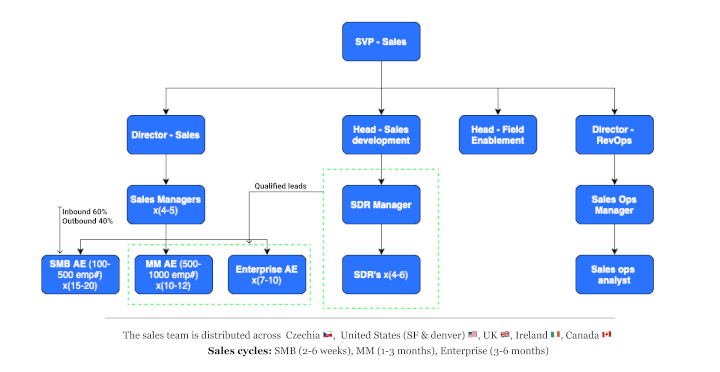How Productboard will become the Salesforce of product management 🚀
How Productboard will become the Salesforce of product management 🚀
How Productboard will become the Salesforce of product management 🚀
The secret to Productboard's success, a world-class go-to-market (GTM) strategy
The secret to Productboard's success, a world-class go-to-market (GTM) strategy
The secret to Productboard's success, a world-class go-to-market (GTM) strategy



Twentieth of August, 2011. The day Marc Andreeson famously proclaimed that 'software is eating the world'.
It's been 10 years since that day and I think it's safe to say that software has eaten the world. The last decade saw technology companies rise to the top of the public market indices, accompanied by an influx of talent flowing into tech and startups. What was viewed as a volatile and hacky industry transitioned to more stable and structured operations. And with that came the rise of technical roles that were relatively unheard of in the 2000s - product marketing, developer relations, and growth amongst others.
But no role has exploded more in ubiquity and importance than product management! (PM)
And that's where our growth story for the day starts. In the offices of a high-growth startup in San Francisco where former PM, and newly-minted VP of Product 🥳, Hubert Palan has an epiphany. Hubert realized that most of his product management work was centered around customers - learning about their needs, market analysis, looking at available solution alternatives, and then ultimately, prioritization of the opportunities that you see in the market. The focal point of a PM's job is the customer!

"If you look at product management, it’s about customers and their needs on one side, and then the products and services that you offer to them on the other. But the customers and their needs are completely missing from the systems that we use.. There’s no entity of a customer in Jira, for example, which is mind-boggling 🤯 That’s the foundation!" - Hubert Palan
Product management lacked a CRM-equivalent platform! This was the insight that started it all - connecting customers with product. In 2015, after 13 iterations of the product, Productboard launched! It's been over six years since then and the company is a rocketship on the precipice of unicorn status 🦄 So how did they get there? It's no secret they have an amazing product! But what's less spoken of is their go-to-market (GTM) motion:
From inviting virality through a smart pricing strategy, to
Building one of the best onboarding and customer success experiences, to
Building a sales engine to move upmarket
Productboard has taken just a few years to flawlessly execute what most falter on for decades!
🤑 Virality through pricing
The most legendary SaaS companies are ones who are able to grow past their first product and serve multiple use cases and personas - Salesforce, Hubspot, Atlassian, Stripe.
And Productboard wants to do just that if you dig deeper into the company's pricing plan! 🤫 Users are segmented into two main categories:
Makers: Those who make active and frequent edits to product boards and roadmaps. Aka product managers.
Contributors and viewers: Those who aren't heavily involved in the product management process but are spectators (and commentators) to product roadmaps and upcoming feature releases. Aka engineers, product marketers, designers & leadership.
Productboard only charges customers for the number of makers using the product. All contributors and viewer seats are FREE!

And the results are apparent. We spoke to a bunch of companies using Productboard and all noted that a majority of their users are contributors and viewers - often over 70-80% of total Productboard users within the org!
For a company with ambitions to serve multiple use cases and personas, this viral flywheel is key!
🤝 A world-class onboarding experience
When John Henwood was brought in to lead Productboard's customer success function in August 2019, he started by asking a simple question.
Which customers are getting the most success from the product? And how do they compare to those who are struggling the most? How do the two groups differ based on product usage behavior, engagement & firmographic indicators.
And what popped out of that analysis as the biggest lever to ensure success - the onboarding process! In hindsight, this is a problem most companies serving new/emerging market segments face. After all, product management is a relatively new function, and the set of frameworks and best practices are limited at best.
"And so we've really focused on how do we help educate them, get them up and running and avoid that blank page problem, and start to help drive them forward." - John Henwood, Director - Customer success
Here's how Productboard went about solving their onboarding problem:
Segmentation: The customer success team worked closely with the growth team and segmented their customers base into unique personas. The team then studied the set of users journeys that each persona needed to go through to find that 'Aha' moment. The team then instrumented both (a) in product engagements and (b) outside of product engagement (like email, calls, etc.) to ensure that users went through the motions to ensure that 'Aha' moment.

Solutions architect function: Productboard has a strong PLG motion nearly all of its revenue comes from a two-week trial. The company noticed that (prior to setting up customer success) users were going through the following journey:

"By the time users went through onboarding, they had already been in the product for a month or two, setting things up incorrectly and getting frustrated"
And so Productboard made a big bet on bringing in a solutions architect function early in the process to handhold customers through this onboarding process. Unlike other companies where solutions architects report into the sales function, at Productboard they are part of the customer success org. The team assists users with taking their first actions in the product, creating their first few boards, configuring the settings inline the user's needs, and most important, handhold customers through the change management that's necessary to ensure a successful onboarding 💪🏻
Defining a leading indicator to success: Although gross revenue retention (GRR) and net revenue retention (NRR) are the north star metrics for most SaaS customer success functions - these are both lagging indicators of performance 🤔
Productboard instead created a proprietary leading indicator to success - a programmatic health score!
A score which compares product engagement signals for all users within a certain pricing tier and customer persona segment, against :
Their peers who are using the product, and
Against themselves and what their behavior was previously
🚀 Moving upmarket with Sales

Most legendary SaaS companies have started their journey downmarket, selling first to the smallest of companies (SMBs, startups running out of garages) and eventually moving upmarket to serve the largest behemoths of the world. Stripe. Shopify. Even Salesforce!
Productboard is moving upmarket too! And it only makes sense - the company has an enterprise-ready product and is now hiring the team to help sell it!

The flexible and remote team at Productboard is driven by an outcome-first sales culture. The team works with monthly quotas and is supported by dedicated sales enablement & ops teams in their pursuit. The team is inducted following a 2-week training across processes, systems, and tools and are equipped with an arsenal including:
Salesforce as the sales CRM
Intercom as a communication channel with customers
Outreach for streamlining and automating customer engagement
Chorus for call transcription
LeadIQ for LinkedIn prospecting
RevOps for drawing out contracts
Zendesk for customer support
and... Productboard for customer feedback 😉
⏭ What's next - the second act
Productboard is aggressively charging upmarket and the day is not far when the company calls 95%+ of the Fortune 500 list its customer!

However, the opportunity is much larger! Productboard is sitting atop a goldmine of users it considers 'viewers and contributors'. 💰 Over 70-80%+ of its total userbase according to our estimates! Product marketing, customer success, Engineering Blog amongst other teams, could all use a platform that integrates more deeply with feedback and insights from the end customers of the software.
Every time a new role is born so is a "Salesforce-like" system of record software! Inbound marketers created Hubspot. Product designers, Figma. API developers, Postman. And Productboard has a legitimate shot of being the Salesforce of Product Management!
Twentieth of August, 2011. The day Marc Andreeson famously proclaimed that 'software is eating the world'.
It's been 10 years since that day and I think it's safe to say that software has eaten the world. The last decade saw technology companies rise to the top of the public market indices, accompanied by an influx of talent flowing into tech and startups. What was viewed as a volatile and hacky industry transitioned to more stable and structured operations. And with that came the rise of technical roles that were relatively unheard of in the 2000s - product marketing, developer relations, and growth amongst others.
But no role has exploded more in ubiquity and importance than product management! (PM)
And that's where our growth story for the day starts. In the offices of a high-growth startup in San Francisco where former PM, and newly-minted VP of Product 🥳, Hubert Palan has an epiphany. Hubert realized that most of his product management work was centered around customers - learning about their needs, market analysis, looking at available solution alternatives, and then ultimately, prioritization of the opportunities that you see in the market. The focal point of a PM's job is the customer!

"If you look at product management, it’s about customers and their needs on one side, and then the products and services that you offer to them on the other. But the customers and their needs are completely missing from the systems that we use.. There’s no entity of a customer in Jira, for example, which is mind-boggling 🤯 That’s the foundation!" - Hubert Palan
Product management lacked a CRM-equivalent platform! This was the insight that started it all - connecting customers with product. In 2015, after 13 iterations of the product, Productboard launched! It's been over six years since then and the company is a rocketship on the precipice of unicorn status 🦄 So how did they get there? It's no secret they have an amazing product! But what's less spoken of is their go-to-market (GTM) motion:
From inviting virality through a smart pricing strategy, to
Building one of the best onboarding and customer success experiences, to
Building a sales engine to move upmarket
Productboard has taken just a few years to flawlessly execute what most falter on for decades!
🤑 Virality through pricing
The most legendary SaaS companies are ones who are able to grow past their first product and serve multiple use cases and personas - Salesforce, Hubspot, Atlassian, Stripe.
And Productboard wants to do just that if you dig deeper into the company's pricing plan! 🤫 Users are segmented into two main categories:
Makers: Those who make active and frequent edits to product boards and roadmaps. Aka product managers.
Contributors and viewers: Those who aren't heavily involved in the product management process but are spectators (and commentators) to product roadmaps and upcoming feature releases. Aka engineers, product marketers, designers & leadership.
Productboard only charges customers for the number of makers using the product. All contributors and viewer seats are FREE!

And the results are apparent. We spoke to a bunch of companies using Productboard and all noted that a majority of their users are contributors and viewers - often over 70-80% of total Productboard users within the org!
For a company with ambitions to serve multiple use cases and personas, this viral flywheel is key!
🤝 A world-class onboarding experience
When John Henwood was brought in to lead Productboard's customer success function in August 2019, he started by asking a simple question.
Which customers are getting the most success from the product? And how do they compare to those who are struggling the most? How do the two groups differ based on product usage behavior, engagement & firmographic indicators.
And what popped out of that analysis as the biggest lever to ensure success - the onboarding process! In hindsight, this is a problem most companies serving new/emerging market segments face. After all, product management is a relatively new function, and the set of frameworks and best practices are limited at best.
"And so we've really focused on how do we help educate them, get them up and running and avoid that blank page problem, and start to help drive them forward." - John Henwood, Director - Customer success
Here's how Productboard went about solving their onboarding problem:
Segmentation: The customer success team worked closely with the growth team and segmented their customers base into unique personas. The team then studied the set of users journeys that each persona needed to go through to find that 'Aha' moment. The team then instrumented both (a) in product engagements and (b) outside of product engagement (like email, calls, etc.) to ensure that users went through the motions to ensure that 'Aha' moment.

Solutions architect function: Productboard has a strong PLG motion nearly all of its revenue comes from a two-week trial. The company noticed that (prior to setting up customer success) users were going through the following journey:

"By the time users went through onboarding, they had already been in the product for a month or two, setting things up incorrectly and getting frustrated"
And so Productboard made a big bet on bringing in a solutions architect function early in the process to handhold customers through this onboarding process. Unlike other companies where solutions architects report into the sales function, at Productboard they are part of the customer success org. The team assists users with taking their first actions in the product, creating their first few boards, configuring the settings inline the user's needs, and most important, handhold customers through the change management that's necessary to ensure a successful onboarding 💪🏻
Defining a leading indicator to success: Although gross revenue retention (GRR) and net revenue retention (NRR) are the north star metrics for most SaaS customer success functions - these are both lagging indicators of performance 🤔
Productboard instead created a proprietary leading indicator to success - a programmatic health score!
A score which compares product engagement signals for all users within a certain pricing tier and customer persona segment, against :
Their peers who are using the product, and
Against themselves and what their behavior was previously
🚀 Moving upmarket with Sales

Most legendary SaaS companies have started their journey downmarket, selling first to the smallest of companies (SMBs, startups running out of garages) and eventually moving upmarket to serve the largest behemoths of the world. Stripe. Shopify. Even Salesforce!
Productboard is moving upmarket too! And it only makes sense - the company has an enterprise-ready product and is now hiring the team to help sell it!

The flexible and remote team at Productboard is driven by an outcome-first sales culture. The team works with monthly quotas and is supported by dedicated sales enablement & ops teams in their pursuit. The team is inducted following a 2-week training across processes, systems, and tools and are equipped with an arsenal including:
Salesforce as the sales CRM
Intercom as a communication channel with customers
Outreach for streamlining and automating customer engagement
Chorus for call transcription
LeadIQ for LinkedIn prospecting
RevOps for drawing out contracts
Zendesk for customer support
and... Productboard for customer feedback 😉
⏭ What's next - the second act
Productboard is aggressively charging upmarket and the day is not far when the company calls 95%+ of the Fortune 500 list its customer!

However, the opportunity is much larger! Productboard is sitting atop a goldmine of users it considers 'viewers and contributors'. 💰 Over 70-80%+ of its total userbase according to our estimates! Product marketing, customer success, Engineering Blog amongst other teams, could all use a platform that integrates more deeply with feedback and insights from the end customers of the software.
Every time a new role is born so is a "Salesforce-like" system of record software! Inbound marketers created Hubspot. Product designers, Figma. API developers, Postman. And Productboard has a legitimate shot of being the Salesforce of Product Management!
Related Articles




Behavioral Retargeting: A Game-Changer in the Cookieless Era
Unlock the power of behavioral retargeting for the cookieless future! Learn how it personalizes ads & boosts conversions. #behavioralretargeting




All of Toplyne's 40+ Badges in the G2 Spring Reports
Our customers awarded us 40+ badges in G2's Summer Report 2024.




Unlocking the Full Potential of Google PMax Campaigns: Mastering Audience Selection to Double Your ROAS
Copyright © Toplyne Labs PTE Ltd. 2024
Copyright © Toplyne Labs PTE Ltd. 2024
Copyright © Toplyne Labs PTE Ltd. 2024
Copyright © Toplyne Labs PTE Ltd. 2024